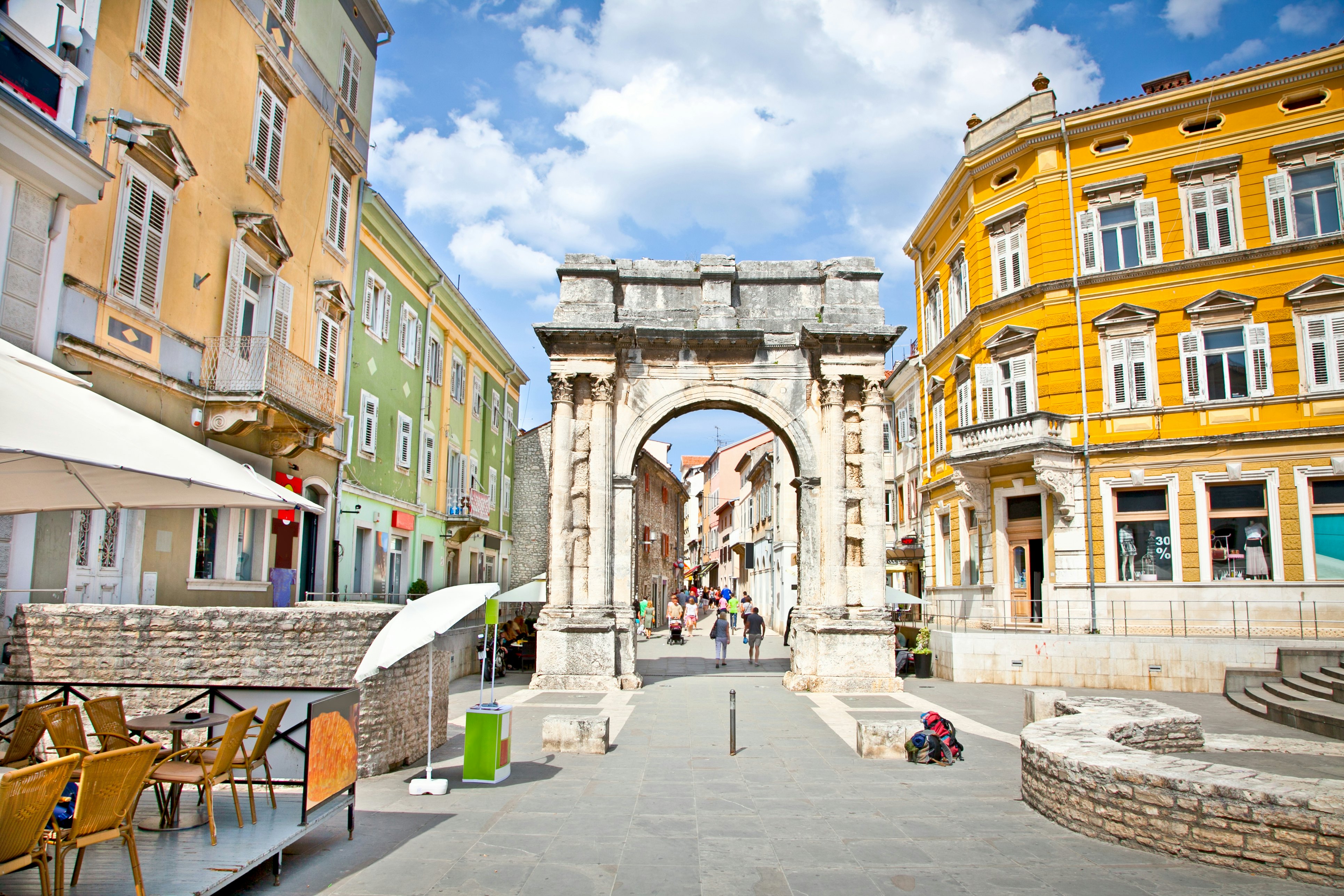

The Roman history of Istria still stands tall © Imantsu / Getty Images
One of Istria’s most celebrated monuments is the Arena, the magnificent 1st century Roman amphitheater that’s a symbol of Pula, the peninsula’s biggest city. The sea-facing amphitheater is also an icon of ancient Rome, and the grandest and best-preserved example of how the Romans left their mark on Istria forever.
But there are plenty more astonishing Roman-era monuments to explore in Pula, as well as in the city of Poreč and on the nearby Brijuni Islands. Spend time in Istria and you’re bound to come across vestiges of its Roman past in the many ancient relics and architectural testaments that have stood here for millennia.
You'll See This Everywhere in Croatia: Roman Ruins
A past marked by emperors, rulers and monarchs
Istria was under the rule of the Roman Empire for centuries, followed by a series of Italian and German kingdoms before the Venetian Republic took hold from 1331 to 1797. The peninsula then fell under the reign of the Austrian Habsburgs (1797–1805) and Napoleon for a short time (1805–1814), before going back to Austro-Hungarian rule for 105 years. Between the two World Wars, borders were redrawn and Istria became part of Italy before finally falling under Yugoslavia in 1947. Since the break up of Yugoslavia in 1991, Istria is one of Croatia’s 20 counties.
Of all these various kingdoms, republics and empires, the Romans governed Istria the longest – for over 650 years – from 177 BCE to the downfall of their empire in 476 CE. During this period, the Romans had plenty of time to leave their mark. They built tidy cities lined with grids of stone-paved streets along with grandiose buildings and villas, and they planted vast olive groves. They also constructed memorial arches, majestic temples and open-air theaters.

Tracing Pula’s rich Roman past
The city of Pula has the largest number of remaining ancient Roman relics in Istria. Made entirely of limestone, the iconic Arena dates back to the 1st century and is one of only four remaining Roman amphitheaters in the world still in use today
The best way to experience the Arena’s special atmosphere is during the annual Pula Film Festival or at a big-ticket summer concert, when you can sit under the stars among its ancient stones and imagine rubbing elbows with the 20,000 Roman spectators who once watched gladiators battle here.
On Trg Portarata stands the Arch of the Sergii, a triumphal arch built in 27 BCE that was once one of the city’s 12 gates. It opens onto a cobblestone lane leading through a clutch of narrow pedestrian streets. Look for the sign pointing the way to the well-preserved 3rd century Roman floor mosaics, which were once the exquisite floors of a Roman villa.
At the heart of Roman "Pola" was the Forum, a vast square dominated by the pillared Temple of Augustus, constructed sometime between 2 BCE and 14 CE. Pause at one of the many cafes to take in the architectural vestiges of the Roman past on a square that has been a gathering place for millennia.
Pula’s 1st century small Roman theater was given a new breath of life in 2023 when it was restored and open to the public. During the summer, the semi-circular theater’s ancient stones seat up to 1700 for intimate open-air concerts, theater productions and other cultural events.

Poreč: Istria’s ancient Roman capital
Tucked away on a narrow peninsula only 500m (1640ft) long and 200m (656ft) wide, the Roman past of the old town of Poreč is unmistakable. This seaside city was called Parentium during Roman times, when it served as the capital of Istria.
The car-free old town’s grid of cobblestone lanes and passageways was built according to the typical Roman street layout, with Decumanus as its main thoroughfare running east-west, intersecting with the north-south Cardo Maximus.
The square known as Trg Marafor is the site of the Roman Forum, the ancient city’s central hub which is today taken over by sidewalk cafes and restaurants. Scattered nearby lie the age-old remains and stone columns of the Temple of Neptune, built in the 1st century and dedicated to the god of the sea.
Built on the remains of 4th and 5th century Roman temples, is Poreč’s star attraction, the magnificent Episcopal Complex of the Euphrasian Basilica, a UNESCO World Heritage Site and one of the finest examples of Byzantine art and architecture in Europe. The complex is made up of an early Christian church, atrium, baptistery and episcopal palace, and dates back to 553 CE.
Step into the basilica to admire the dazzling Byzantine mosaics of gold leaf decorating its semi-circular apse. If you’re visiting between July and September, come for one of the weekly concerts and the chance to enjoy classical music in this splendid setting.

On the Roman trail on Veliki Brijun Island
Once the summer residence and playground of Yugoslav president Tito, the Brijuni Islands, located just off Istria’s south-west coastline, are today one of Croatia’s six national parks. Scattered on Veliki Brijun, the biggest island making up Brijuni National Park, are a collection of magnificent Roman ruins and relics.
On the edge of Dobrika Bay lie the stone remains of the Byzantine Castrum, an ancient settlement sandwiched between thick defensive walls and the sea. It started out as a villa built by the Romans in the 1st century, expanding during the 4th century to cover a rectangular stretch of almost one hectare (2.5 acres). Search among the maze of scattered old stones to find olive presses, cellars, cisterns and brick ovens, the everyday implements left behind by its ancient inhabitants.
The Roman Villa was a lavish summer residence perched on the edge of Verige Bay on the island’s east coast. The stone foundations of the 1st century villa are visible here, as are the columns of its two colonnaded peristyles, and stone steps leading down to circular baths. Stand among the age-old stones and imagine when this was a vast and grand complex of interconnected marble and stucco buildings embellished with intricate mosaics and colorful frescoes.
Another Roman-era highlight is the island’s massive 1600-year-old olive tree, one of the few remaining trees of what was once an ancient olive grove planted here by the Romans. At the time, olive oil from Istria was exported in terracotta amphorae by ship throughout the empire. The tree still amazingly bears fruit, which is picked at each harvest-time and pressed for oil.
















